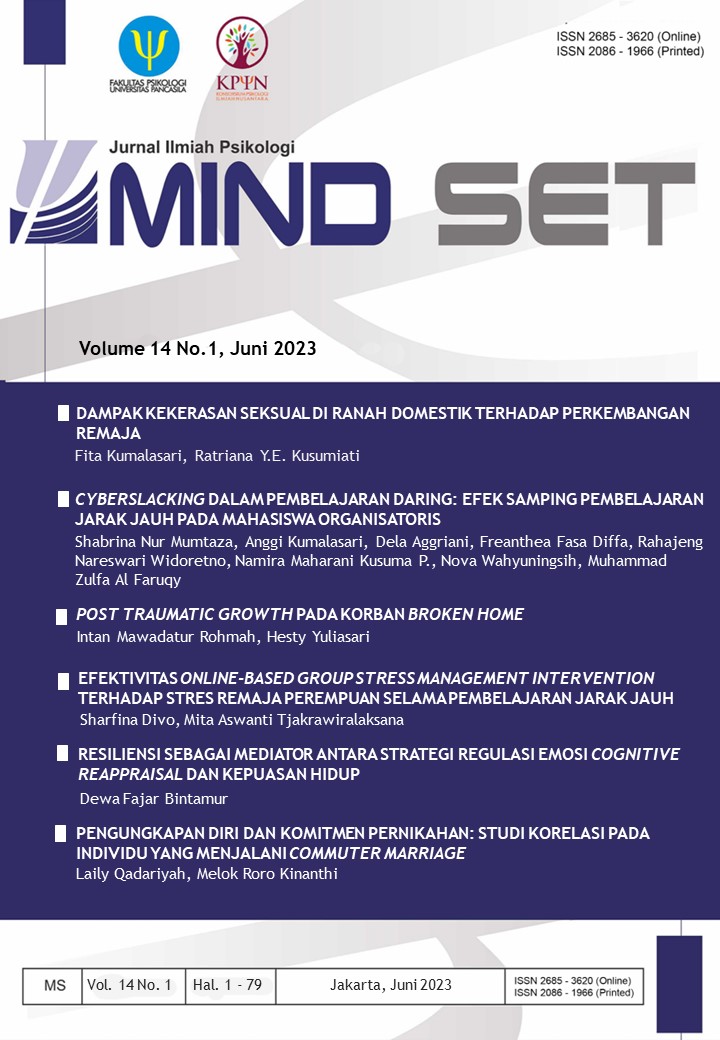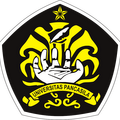Cyberslacking dalam Pembelajaran Daring: Efek Samping Pembelajaran Jarak Jauh pada Mahasiswa Organisatoris
Abstract
This research discusses the phenomenon of cyberslacking among organizational students during online learning in the Covid-19 pandemic. The aim of the study is to explore the forms and reasons why organizational students engage in cyberslacking. This exploratory qualitative study involved 100 organizational students (16% male; 84% female) who participated in online learning at University X Semarang. Data were collected using a Google Form (open and closed questions) distributed through social media platforms. The results showed that the majority of organizational students engaged in cyberslacking by accessing social media platforms such as WhatsApp (25.5%), LINE (19.8%), and Instagram (19.5%), and common forms of cyberslacking activities were chatting (47.6%), scrolling (28%), and seeking entertainment (18.2%). Organizational students engaged in cyberslacking due to feeling bored (50%), having urgent matters (18%), and feeling tired (13%). Although they felt entertained, organizational students also felt guilty, worried, and unfocused during cyberslacking activities. Organizational students perceived their role as having responsibilities, wanting to apply knowledge, and being useful, so sometimes they had to engage in cyberslacking when there were important notifications related to their organization. The implications of this study emphasize the importance of self-regulation in learning for organizational students and the role of educational institutions in ensuring the effectiveness and efficiency of online learning.
References
Akbulut, Y., Dursun, Ö. Ö., Dönmez, O., & Şahin, Y. L. (2016). In search of a measure to investigate cyberloafing in educational settings. Computers in Human Behavior, 55, 616–625. https://doi.org/10.1016/j.chb.2015.11.002
Alfaruqy, M. Z. (2020). Generasi milenial: Relasi sosial dan perilaku politiknya. Dalam M.Z. Alfaruqy & D.R. Sawitri (Eds.). Dinamika keluarga & komunitas dalam menyambut society 5.0 (pp 70-81). Fakultas Psikologi Universitas Diponegoro.
Alfaruqy, M. Z. (2022). Generasi Z dan nilai-nilai yang dipersepsikan dari orangtuanya. Psyche, 4(1), 84-95.
Alfaruqy, M. Z., Dewi, A.C., & Emeralda, V.T. (2022). Konstruksi sosialisasi nilai: Perspektif remaja dan orangtuanya. Psychocentrum Review, 4(1), 55-66.
Anam, K., & Pratomo, A. G. (2019). Fenomena cyberslacking pada mahasiswa. Intuisi: Jurnal Psikologi Ilmiah, 11(3), 202–210. https://doi.org/10.15294/intuisi.v11i3.23378
Anugrah, A. P., & Margaretha, M. (2013). Regulasi diri mempengaruhi perilaku cyberloafing yang dimoderasi oleh berbagai karakteristik individual mahasiswa. Universitas Kristen Maranatha. Seminar Nasional dan Call For Paper. 28, 4
Apuke, O. D., & Iyendo, T. O. (2018). University students’ usage of the internet resources for research and learning: forms of access and perceptions of utility. Heliyon, 4(12), e01052. https://doi.org/10.1016/j.heliyon.2018.e01052
Arabaci, I. (2017). Investigation faculty of education students’ cyberloafing behaviors. The Turkish Online Journal of Educational Technology. Retrieved from https://files.eric.ed.gov/fulltext/EJ1124916.pdf
Ardilasari, N., & Firmanto, A. (2017). Hubungan self control dengan perilaku cyberloafing pada pegawai negeri sipil. Jurnal ilmiah psikologi terapan, 5(1), 19-39.
Arsyad, A. (2011). Media pembelajaran. Rajawali Pers.
Bayu, N. A. (2020). Sistematik review: Dampak perkuliahan daring saat pandemi covid-19 terhadap mahasiswa indonesia. Jurnal Ilmiah Kesehatan. 8(2), 99-108.
Barnes, N. G. (2009). Reaching the wired generation: How social media is changing college admission. National Association for College Admission Counseling. Retrieved 10 October 2015 http://www.nacacnet.org/publicationsresources/marketplace/discussion/pages/socialme diadiscussionpaper.aspx.
Benedita, R. (2018). Pengaruh Beban Kerja, Peran Ganda, dan Lingkungan Kerja terhadap Perilaku Cyberloafing Pegawai (Studi Kasus pada Dinas Pendidikan dan Kebudayaan Kota Tangerang Selatan). [unpublished undergraduate’s thesis]. UIN Syarif Hidayatullah Jakarta.
CNN Indonesia. (2020, August 11). Bagaimana Corona Menular dari Satu Orang ke Hampir 100 Orang. CNN Indonesia. Retrieved from https://www.cnnindonesia.com
Deng, L., Ku, K. Y. L., & Kong, Q. (2019). Examining predictive factors and effects of inclass multitasking with mobile phones. Interactive Technology and Smart Education, 16(1), 49–58. https://doi.org/10.1108/ITSE-08-20180056 31
Fuadiah, L., Anward, H. H, & Erlyani, N. (2016). Peranan conscientiousness terhadap perilaku cyberloafing pada mahasiswa.
Gerow, J. E., Galluch, P. S., & Thatcher, J. B. (2010). To slack or not to slack: Internet usage in the classroom. JITTA: Journal of Information Technology Theory and Application, 11(3), 5–23.
Gökçearslan, Ş., Mumcu, F. K., Haşlaman, T., & Çevik, Y. D. (2016). Modelling smartphone addiction: The role of smartphone usage, self-regulation, general self-efficacy and cyberloafing in university students. Computers in Human Behavior, 63, 639–649. https://doi.org/10.1016/j.chb.2016.05.091
Greenhaus, J., Pasuraman, S., & Collins, K. (2001). Career involvement and family involvement as moderators of relationships between work-family conflict and withdrawal from a profession. Journal of Occupational Health Psychology, 6,91-100. doi: 10.1037//1076-8998.6.2.91
Hurriyati, D., & Oktaviana, R. (2017). Analisa faktor-faktor yang mempengaruhi perilaku cyberloafing pada pegawai negeri dinas pekerjaan umum Kota Palembang. Jurnal Ilmiah Psyche, 11(2), 75-86.
Ichwal, H. (2014). Manusia kampus potret kultural mahasiswa UNJ. Pustaka Kaji.
Isman. (2016). Pembelajaran moda dalam jaringan (MODA DARING).
Jacobsen, W. C., & Forste, R. (2011). The wired generation: Academic and social outcomes of electronic media use among university students. Cyberpsychology, Behavior, and Social Networking, 14(5), 275e280. http://dx.doi.org/10.1089/cyber.2010.0135.
Jayani, D. H., (2021, September 15). Capai 4,17 Juta, Kasus Covid-19 Indonesia Tertinggi Keempat di Asia. Retrieved from https://databoks.katadata.co.id/
Kabiba, K., Arfin, A., & Junaidin, J. (2021). Faktor penyebab terjadinya konflik peran dalam proses pembelajaran pada mahasiswa pengurus organisasi, Didaktis: Jurnal Pendidikan dan Ilmu Pengetahuan, 21(1). 76-85.
Kastolani, B. (2019). Here and now. Majalah Suara Muhammadiyah Edisi 20.
Kim, S. J., & Byrne, S. (2011). Conceptualizing personal web usage in work contexts: A preliminary framework. Computers in Human Behavior, 27(6), 2271-2283. https://doi.org/10.1016/j.chb.2011.07.006
Kim, U., Yang, K.-S., & Hwang, K.-K. (2012). Paternalism. In The Routledge Companion to Philosophy of Law. https://doi.org/10.4324/9780203124352
Lavoie, J. A. A., & Pychyl, T. A. (2001). Cyberslacking and the procrastination superhighway. Social Science Computer Review, 19(4), 431–444. https://doi.org/10.1177/089443930101900403
Lim, V.K.G., (2002). The IT way of loafing on the job: cyberloafing, neutralizing and organizational justice. Journal of Organizational Behavior, 23(5), 675– 694. https://doi.org/10.1002/job.161
Mahmudah, R. & Alfaruqy, M.Z. (2021). Hubungan antara dukungan sosial orang tua dengan penyesuaian diri mahasiswa baru yang mengikuti pembelajaran daring di Fakultas Psikologi Universitas Diponegoro [undergraduate’s thesis]. Universitas Diponegoro.
Mansyur, A. R. (2020). Dampak covid-19 terhadap dinamika pembelajaran di Indonesia. Education and Learning Journal, 1(2), 113-123. https://dx.doi.org/10.33096/eljour.v1i2.55
Marron, K. (2000). Attack of the cyberslackers. The Globe and Mail, 5.
Meier, A., Reinecke, L., & Meltzer, C. E. (2016). “Facebocrastination”? Predictors of using Facebook for procrastination and its effects on students‟ well-being. Computers in Human Behavior, 64, 65-76. https://doi.org/10.1016/j.chb.2016.06.011
Moskal, P., Dziuban, C., & Hartman, J. (2013). Blended learning: A dangerous idea? The Internet and Higher Education, 18, pp.15–23.
Mulyana, M., Rainanto, B. H., Astrini, D., & Puspitasari, R. (2020). Persepsi mahasiswa atas penggunaan aplikasi perkuliahan daring saat wabah covid-19. Jurnal Analisis Sistem Pendidikan Tinggi, 4(1). 47-56. https://doi.org/10.36339/jaspt.v4i1.30
Ningsih, S. (2020). Persepsi mahasiswa terhadap pembelajaran daring pada masa pandemi covid-19. JINOTEP: Jurnal Inovasi Teknologi Pembelajaran, 7(2). 124-132.
O‟Neill, T. A., Hambley, L. A., & Chatellier, G. S. (2014). Cyberslacking, engagement, and personality in distributed work environments. Computers in Human Behavior, 40, 152- 160. https://doi.org/10.1016/j.chb.2014.08.005.
Pohan, A. E. (2020). Konsep pembelajaran daring berbasis pendekatan ilmiah. CV. Sarnu Untung.
Prihartanti, W. N., & Wiryosutomo, H. W. (2020). Hubungan antara keaktifan siswa berorganisasi dan kemampuan manajemen waktu dengan perilaku belajar siswa di SMA Negeri Surabaya. Jurnal BK UNESA, 11(1).
Robbins, S. P., & Judge, A. T. (2008). Perilaku organisasi edisi 12. Salemba Empat.
Sadikin, A., & Hamidah, A. (2020). Pembelajaran daring di tengah wabah covid-19. BIODIK: Jurnal Ilmiah Pendidikan Biologi, 6(02), 214-224. https://doi.org/10.22437/bio.v6i2.9759
Sanbonmatsu, D. M., Strayer, D. L., Medeiros-Ward, N., & Watson, J. M. (2013). Who multitasks and why? multitasking ability, perceived multi-tasking ability, impulsivity, and sensation seeking. PLoS ONE. https://doi.org/10.1371/journal.pone.0054402
Sari, I.A. & Alfaruqy, M.Z. (2021). Ikatan relasi suami-istri: Dinamika keputusan menikah saat pandemi COVID-19. Psikostudia Jurnal Psikologi, 10(3), 226-236.https://doi.org/10.30872/psikostudia
Siallagan, D. F. (2011). Fungsi dan peranan mahasiswa.
Simanjuntak, E., Fajrianthi, Purwono, U., & Ardi, R. (2019). Skala cyberslacking pada mahasiswa. Jurnal Psikologi Universitas Diponegoro, 18(1), 41-54. https://doi.org/10.14710/jp.18.1.55-68
Simanjuntak, E., Nawangsari, N. A. F., & Ardi, R. (2018). Cyberslacking among university students: The role of internet habit strength, media multitasking efficacy and self regulated learning. Proceedings of the International Conference on Psychology in Health, Educational, Social and Organizational Settings, Surabaya, Indonesia (pp. 8-9). 33.
Sukanto, D. (2020). Pembelajaran jarak jauh dengan media e-learning sebagai solusi pembelajaran pada masa pandemic coronavirus disease 2019 (covid-19). Jurnal Syntax Idea, 2(11), 834-850. https://doi.org/10.36418/syntax-idea.v2i11.679.
Taneja, A., Fiore, V., & Fischer, B. (2015). Cyber-slacking in the classroom: Potential for digital distraction in the new age. Computers & Education, 82, 141–151. https://doi.org/10.1016/j.compedu.2014.11.009.
Vitak, J., Crouse, J., & LaRose, R. (2011). Personal internet use at work: Understanding cyberslacking. Computers in Human Behavior, 27(5), 1751-1759. https://doi.org/10.1016/j.chb.2011.03.002.
Weaver, B.E., & Nilson, L.B. (2005). Laptops in class: What are they good for? What can you do with them? New Directions for Teaching and Learning, 2005(101), 3–13. https://doi.org/10.1002/tl.181
Weber, R. (1990). Techniques of content analysis. In Basic content analysis. SAGE Publications, Inc. https://www.doi.org/10.4135/9781412983488.
Wu, J. Y. (2017). The indirect relationship of media multitasking self-efficacy on learning performance within the personal learning environment: Implications from the mechanism of perceived attention problems and self regulation strategies. Computers and Education. https://doi.org/10.1016/j.compedu.201 6.10.010.
Yilmaz, K. F. G., Yilmaz, R., Ozturk, H. T., Sezer, B., & Karademir, T. (2015). Cyberloafing as a barrier to the successful integration of information and communication technologies into teaching and learning environments. Computers in Human Behavior. https://doi.org/10.1016/j.chb.2014.12.023










